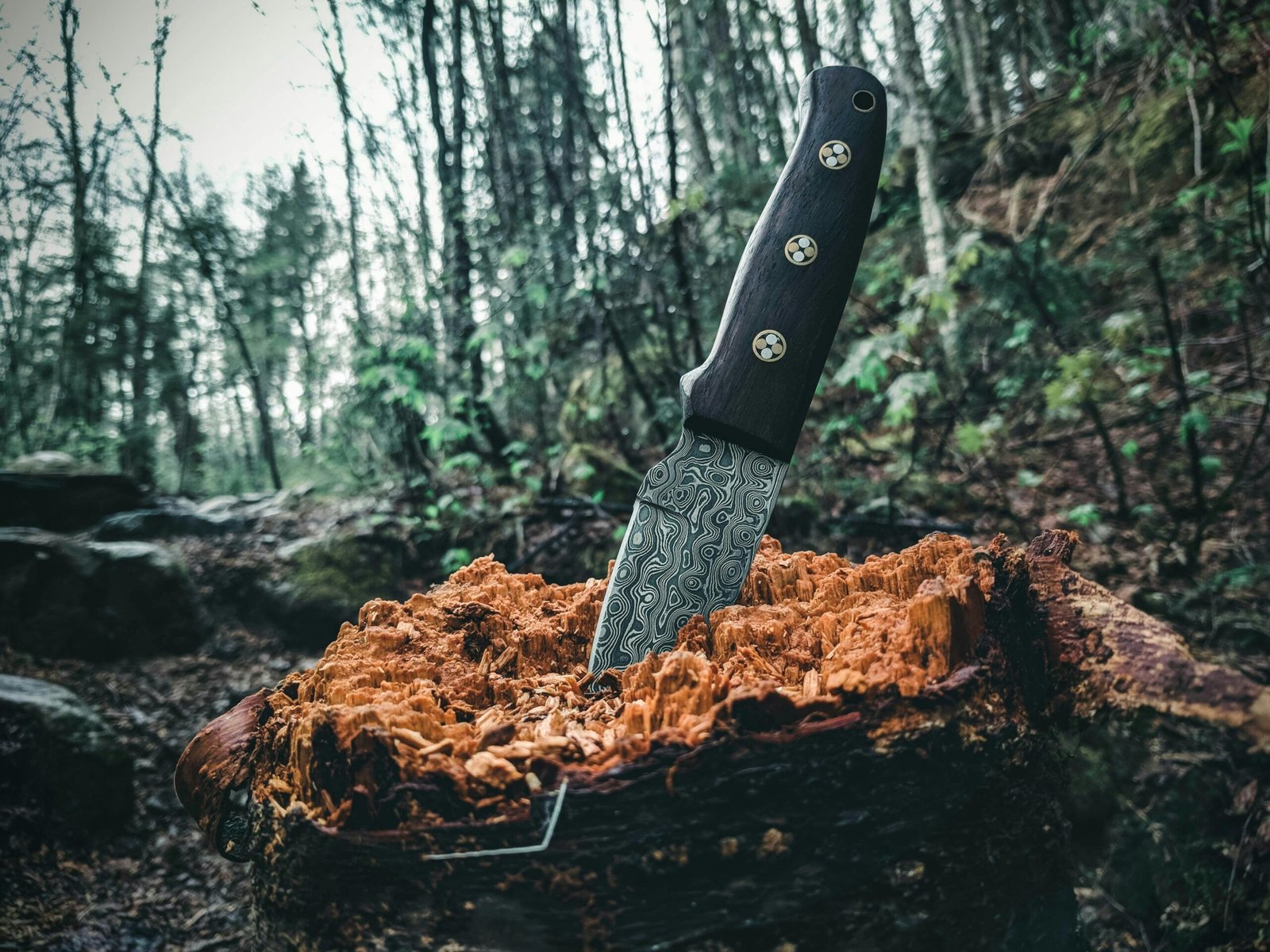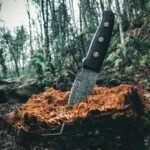If you have a budget bushcraft knife, like a cheap mora for example, it probably doesn’t have all the features an expensive knife does. So here are some mods that you can do to make your knife ten times better.
The best mods for a bushcraft knife are a 90-degree spine you can grind yourself for easy fire starting, a bow drill divot in the handle, a patina on a high carbon blade, a lanyard hole + lanyard, a firesteel pocket on your sheath, and a dangler. Here’s how to make them all easily.
1. 90-degree spine
I never use my firesteel with a striker. Ever. It’s just way easier to do it with the back of my knife. A lot of knives, especially the budget options, don’t have a 90-degree spine on them. this isn’t so bad, even some high-end hunting knives don’t have it, and you can grind one in under 10 minutes. That’s why this is one of my favorite bushcraft knife mods. It’s so easy to do and improves your knife so much!
You basically have the option of grinding it with a file, or with some kind of a power tool. Of course, the file will take more elbow grease and more time, but it has some advantages over a belt sander.
The main reason is that I like to have just two sharpened spine spots on my knife. The first one close to the handle, but not touching, and the other one towards the tip of my knife. The first one is not touching the handle, because when I’m carving, I often put my thumb on the spine of my knife for a controlled, powerful cut. this isn’t very comfortable to do with a sharpened spine.
Having two sharpened spots is helpful when you’re dealing with different tinder. For something like birch bark, I would put my firesteel close to the handle, and for something like fatwood dust, I would put my firestell towards the tip of the knife. It’s just easier that way for me.
So, to grind the spine you will probably need a vice to hold the knife securely, if you don’t have one, you could probably stick your whole knife into a dead standing tree and work off of that. If you are using a vice, though, make sure to put some kind of a cloth to protect the surface of the blade from scratching.
After that, get a file and, trying to maintain a 90-degree angle, start grinding away until you can feel a bur or a “lip” on when you run your finger from the edge towards the spine of the knife.
That process can be done with a power file or a belt sander, but I don’t recommend it as it isn’t as controlled as the hand filing, and can also generate quite a lot of heat which can mess with the tempering of your blade.
Once you can feel that burr, try using your ferro-rod. It will generate a shower of sparks.
2. Bow drill divot
If you are in a pinch and have to start a fire without a ferro rod or a lighter you’re gonna need all the help that you can get. Some knives come with a bow drill divot in the handle designed just with that purpose- for you to have one less thing to worry about when trying to start a bow drill fire.
Some of those are using a copper divot, others are drilled directly into the material of the handle. If you have some basic power tools, it shouldn’t be too hard to make one by yourself.
Bow drill directly into the handle material
Your first and maybe the easiest option is to drill the divot directly into the handle of your knife. This will not work with wooden handles, but if you have micarta or G10 handles it is worth a shot. Just use a somewhat larger masonry drill bit to get that smooth indentation.
One important thing to mention is that whatever the method of drilling the bow drill divot, you should always place it in a way that it can be used while the knife is sheathed. You really don’t want to have your razor sharp edge so close to your hand while you are trying to start a fire.
After you have drilled it out you are mostly ready to go. Some people say that you should lube the divot for better performance, but I don’t think that is a good idea as this oil will get on your hand when you are using your knife for regular tasks. instead what you should do is when it comes time for bow-drilling, just crush up some green leaves and stick them in the divot. this will reduce friction and be a lot easier to clean up.
Bow drill through the scale
An option for wooden handled knives is to drill the hole all the way to the tang of your blade if it is a full exposed tank. This is going to be most easily done if your knife has removable scales. You just take out the scales and drill about 25mm hole from one side, and then put the scales back in. this prevents your dill from hitting the metal or even drilling through it.
Bow drill insert
Another option, maybe the one that’s most popular, is to insert some kind of a metal divot in the knife handle. This eliminates the variables such as handle material or construction. Now I have seen some youtube videos showing how people made divots from bent quarters, but I think the easiest way is to just go to your nearest utility store and buy some copper brass plumbing caps.
They come in a variety of sizes, so you can choose the one suitable for your knife handle. After that, you just cut the cap to size using a hacksaw, then you drill the hole for the divot using a drill bit the same size as your plumbing. After that is done the only thing left is to glue it in place. I would suggest using epoxy for this
If you want to go the extra step you can always epoxy a ball bearing in the handle for buttery smooth motion. For this to work you need to carve your spindle to be a little bigger than the center of your ball bearing, so it moves with it. Just a disclaimer, I haven’t used this method, I don’t know if there is going to be any oil from the ball bearing, or is it going to interfere with your normal knife work, but I just thought I should add that in.
3. Lanyard
Some people hate them, others love them, some just put them for safety. Whatever the case is with you , here are some things to consider when deciding if you want to put a lanyard on your knife, and also how to do it.
Uses of a lanyard
It can be used for a majority of tasks, some for small knives, others for bigger knives.
Most bushcraft knives are sheated pretty deeply – only a small portion of the knife handle is accessible for you to grab on to, which makes them very secure. But that also means that it is a lot harder to unsheathe the knife, especially in cold weather, so a lanyard helps with that.
Another big thing is safety. If you are using a large chopper blade and you slip it is very likely that you will hurt yourself. So that’s where the lanyard comes in. it is very important to use it in a way that the knife cant slip from your hand and hit your elbow or forearm. Make it either extremely tight around your hand or watch this youtube video about lanyard safety:
Also if you are using a small bushcraft knife, first off probably there isn’t a huge bolster to keep your hand from slipping, and also you should get all the help you can get while chopping.
How to drill the hole
So it’s pretty self-explanatory, you just drill a hole at the end of your knife handle. If it’s not full tang you should be able to drill it out pretty easily just with a wood bit. If it’s full tang you might need a drill press with a quality drill bit for steel and some oil to lubricate the steel as you are drilling and also keep it cool.
After that is done you could just sand it a bit, make a bevel and call it a day, or you can insert some kind of a metal tube in the hole to look better, this can be brass, aluminum or even steel. Just make sure to round it off and sand it smooth at the end.
For the lanyard itself, you can use paracord or fancy leather string with bone and metal beads, the easiest way is to double the string, put the loop through the hole, and then loop the loose ends through the loop. make a simple knot after you have measured it and you’re ready. Burn off the paracord to prevent it from untangling and you’re done.
Firesteel pocket
Not all people like to have their firesteel mounted permanently on their knife sheath, but it’s nice because that way you are never going to leave your firesteel at home (which has happened to me personally). On the other hand, If you lose your knife you lose your firesteel. Anyway, whether you like it or not, here is how to do it.
You really do not need a tutorial for this one. Just get a nice quality duct tape and some PVC pipe that is a little bit larger in diameter than your firesteel. Then just wrap it all up. It also helps if your firesteel has some kind of a string to keep it in there.
Dangler
So whether you like to have a dangler on your knife is a whole different discussion, but I think it has some benefits over just using the belt loop. Here is how to make one. There are basically three options:
Buy a knife sheath dangler from amazon or bladehq. They seem pretty good quality and sure are gonna do the job, but are a little pricey.





